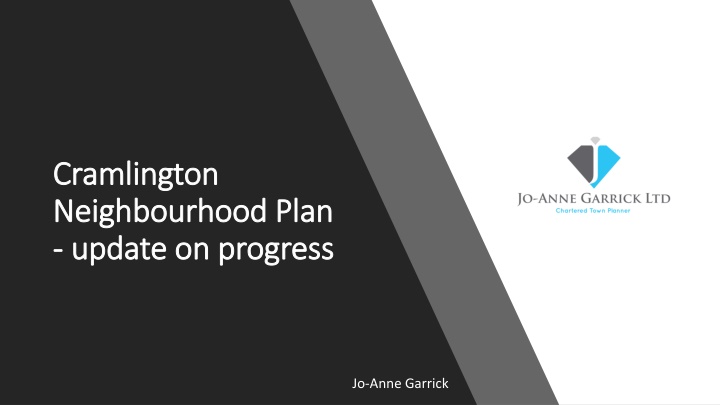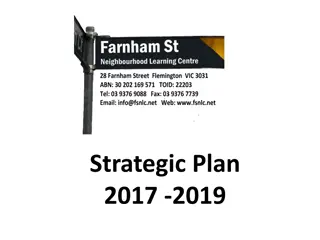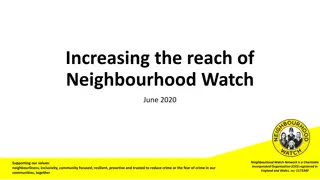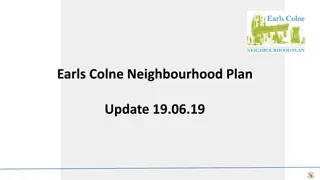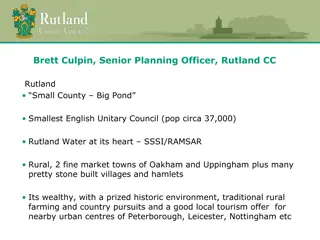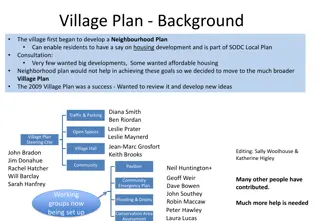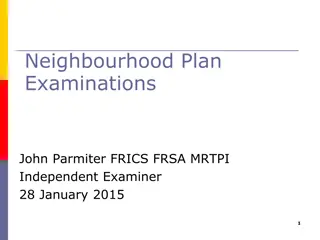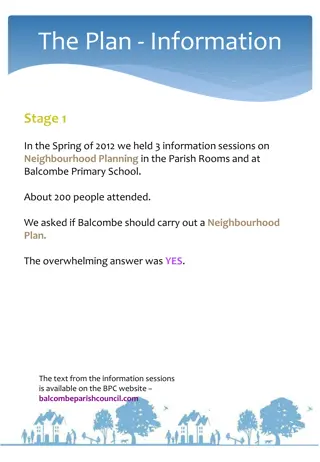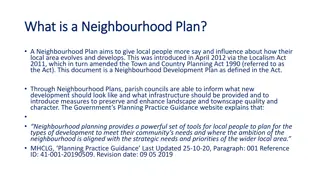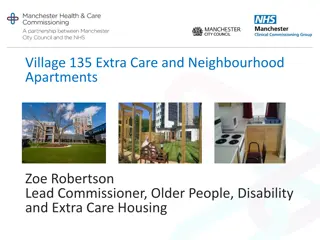Cramlington Neighbourhood Plan Update
The Cramlington Neighbourhood Plan aims for sustainable development, housing delivery, infrastructure provision, economic inclusion, and town center enhancement. It envisions Cramlington as a thriving community offering excellent facilities, work opportunities, and quality housing, with strengthened business locations and reduced commuting. The plan focuses on creating a distinct identity, promoting local businesses, improving connectivity, and ensuring inclusive and caring community services
Download Presentation

Please find below an Image/Link to download the presentation.
The content on the website is provided AS IS for your information and personal use only. It may not be sold, licensed, or shared on other websites without obtaining consent from the author.If you encounter any issues during the download, it is possible that the publisher has removed the file from their server.
You are allowed to download the files provided on this website for personal or commercial use, subject to the condition that they are used lawfully. All files are the property of their respective owners.
The content on the website is provided AS IS for your information and personal use only. It may not be sold, licensed, or shared on other websites without obtaining consent from the author.
E N D
Presentation Transcript
Cramlington Cramlington Neighbourhood Plan Neighbourhood Plan - - update on progress update on progress Jo-Anne Garrick
Background to neighbourhood planning Localism Act 2011 Planning policies and community actions Main purpose set policies for the use and development of land Tested by an Independent Examiner basic conditions Referendum Part of the statutory development plan
Key Issues 1. 2. Sustainable development of the economy Delivery of housing to support local communities and the economy; Provision and maintenance of the infrastructure and services necessary to support communities across Cramlington and the sustainable growth of the town; Promoting social and economic inclusion, and Protecting and enhancing the town centre as a place for retail, commercial and leisure activity. 3. 4. 5.
A vision for Cramlington Cramlington will continue to grow, becoming a successful sustainable community. It will strive to become the main town in the county and one of its principal gateways. Cramlington will be transformed into Northumberland s Garden Town thereby creating a distinct identity for its residential and business communities and visitors.
Outcomes Cramlington will be a place where young people choose to stay to live and work, because of: the excellent education and health facilities, the choice and quality of work, the retail offer, the range of leisure opportunities and access to high quality and suitable housing for all. Taking advantage of its rail and road links, Cramlington will be well connected to the social and economic opportunities provided in Tyneside. It will have strengthened its offer and role as a business location allowing people more opportunity to live and work locally. Growth in the South West Sector and the development of local businesses will have reduced the amount of commuting.
Outcomes (cont) The town centre will be competitive, well managed and accessible from all parts of the town. It will be a retail destination of choice for the surrounding area due to its range of shops, cinema, its lively cultural, social and leisure facilities, which are complemented by its programme of events, festivals and activities. Cramlington will be a caring and inclusive community where everyone has access to the services and facilities the town has to offer. Residents will have access to good quality, protected open spaces underpinned by a network of recreational and cultural facilities. Cramlington will have an integrated approach to travel with improved access to sustainable modes of transport, including easy access to safe and convenient active travel options, so that traffic flow will be more efficient, the town centre will be less congested and have adequate parking.
Objectives 1. Completing our town and extending choice in the housing market; 2. Reinforcing Cramlington s sub-regional employment role; 3. Improving our Town Centre; 4. Investing in our infrastructure; 5. Promoting and integrating sustainable transport; 6. Enhancing the environment; 7. Protecting and enhancing our public open spaces; 8. Creating and supporting thriving and inclusive communities.
Planning Policies Planning for the sustainable development of Cramlington Completing our town and extending housing choice Reinforcing Cramlington s sub-regional employment role Improving our town centre Promoting and integrating sustainable transport Enhancing the environment Thriving and inclusive communities
Sustainable development Policy CNP1: The sustainable development of Cramlington In accordance with the presumption in favour of sustainable development, proposals for major development will be supported where they ensure, where appropriate: a. Cramlington remains a strategic location for growth through development and regeneration, supported by a range of services and facilities; b. The provision of a range of land uses to minimise the need to travel for employment, shopping, leisure, education, health care and social care and other activities; c. A balance between housing and economic growth while protecting, enhancing as well as adding to the town s green spaces; d. Capacity exists, or can be created in physical, social and environmental infrastructure necessary to support new development; e. The effective use of previously developed land and proposals to bring empty buildings back into viable use; f. Links between key areas of the town, including the South West Sector, will be maintained and enhanced to allow safe walking and cycling and effective and efficient public transport connections; g. Constraints on development arising from potential flood risk, contamination or land instability have been effectively assessed and where required, that appropriate risk management, impact mitigation or adaptation will be secured by planning condition or planning obligation as appropriate; h. The quality of the historic environment within the Plan area will be maintained and enhanced; and i. The quality of the biodiversity and natural environment within the Plan area will be maintained and enhanced.
Design Policy CNP2: Promoting good quality design in new development New development must embed high quality design. Development will be supported where it: a. Reflects the density and grain of the surrounding development; b. Takes into account the character of the surroundings; c. Respects and adds to the qualities of the suburban townscapes, reflecting the prevailing scale, layout, mass and form, palette of materials, detailing and finishing; d. Creates attractive spaces by designing and executing good quality boundary treatment and hard and soft landscaping; and e. Ensures that buildings and spaces are easily accessible and safe. Where a Design and Access Statement is required as part of a planning application, there must be a clear demonstration of how the proposal has responded to the above principles as an integral part of the design development process.
Location of new development Policy CNP3: Development in the open countryside New development outside the settlement boundaries of Cramlington and East Hartford, as defined on the Policies Map will be supported where it: a. Is directly related to the business and operational needs of agriculture, forestry or other rural industries; b. Supports the sustainable growth of existing businesses and enterprises; c. Comprises a large-scale major business development that complies with the requirements of Policy CNP9; d. Is a sustainable visitor attraction that is related to the experience or interpretation of the countryside, or a sustainable leisure development which respects the character of the countryside, only where identified needs are not met by existing facilities within the settlement boundary; e. Will provide local services or community facilities which support a rural community; f. Is a house, the design of which: is truly outstanding or innovative and of the highest standard, helping to raise standards of design more generally in rural areas: reflects the highest standards in architecture; significantly enhances its immediate setting; and is sensitive to the defining characteristics of the local area; g. Comprises an appropriately designed extension to an existing building or buildings. The extension should be subservient to and respect the scale and appearance of the host building; or h. Involves the conversion of redundant rural buildings, the building must be structurally sound and its conversion achievable without significant extension to the original structure. The conversion must be in keeping with the character and appearance of the building and its setting.
Housing Policy CNP4: Housing Housing sites that will contribute to the achievement of the sustainable development of the Neighbourhood Plan Area are allocated on the Policies Map. A detailed masterplan for the development of the South West Sector, sustainable urban extension, as defined on the Policies Map, shall be prepared and agreed by the local planning authority prior to commencement of development on the site. The masterplan will: a. Ensure that the new development integrates with the rest of the town and surrounding countryside; Ensure that the new development protects the living conditions of existing residents on the edge of the town; Provide for the social, recreational, educational, open space and transport needs and the associated infrastructure required to support the quality of life of future residents; Incorporate proposals for the construction of a new road bridge, which will cross the East Coast Mail Railway line and link the development with Lancastrian Road; and Clearly define the phasing of development, having regard to the provision and timing of the infrastructure and services necessary to support it. b. c. d. e.
Extending housing choice Policy CNP5: Extending choice in housing Across the Cramlington Neighbourhood Plan Area, a mix of house sizes, types and tenures will be required, to provide for different needs. To ensure that a range and choice of housing is available to meet identified need, the housing mix should include: starter homes, homes for sale, and homes for social and private rent. The housing mix should have regard to and be informed by: a. Evidence of housing needs, including the current Strategic Housing Market Assessment and local housing need assessment; and b. The character and density of surrounding development and site constraints. The only exception to these requirements will be where the proposal is designed to meet a specific and identified housing need, which requires a particular type, format or tenure of housing.
Affordable housing Policy CNP6: Providing lifetime affordable housing All new development that contains more than ten open market residential dwellings and which have a combined floorspace of more than 1,000m2, will be required to contribute to the provision of affordable housing. The level and type of affordable housing to be delivered on each site will have regard to up to date evidence of affordable housing needs. There will be a presumption that the affordable housing contribution will be through the provision of affordable homes on the application site. In exceptional circumstances, off-site provision or a financial contribution, where this can be robustly justified and the following criteria can be met: a. Off-site provision must be on a site that is agreed as being in a suitable location relative to the housing need to be met. Such provision will be secured and controlled by a planning obligation to ensure that the affordable housing is delivered alongside the housing on the principal site; or b. Where a financial contribution to off-site provision of affordable housing is agreed as an alternative to direct provision on site, the sum will be calculated at a rate to be determined at the time of the application by the local planning authority. The contribution will be paid to the local planning authority on commencement of development and will be used to deliver affordable housing within the Neighbourhood Plan Area. Applicants seeking to justify the absence of affordable housing in a scheme will be required, at their own expense, to support their position by providing an independent viability assessment of the scheme costs and end values. The housing provided in pursuit of this policy will be made available to people in housing need at an affordable cost for the life of the property. Any planning permission granted will be subject to appropriate conditions and/or planning obligations to secure: c. The amount and type of affordable housing; d. That the housing will be discounted at an appropriate level to ensure it is affordable by people identified as being in housing need; and e. A mechanism for the management of the new homes to ensure that the first and subsequent occupancies are restricted to people in housing need.
Housing design Policy CNP7: Creatinghigh quality new places throughgood quality housing design and layout All new housing developments in the Cramlington Neighbourhood Plan Area must demonstrate good quality design. New housing development should seek to reflect the character of its immediate surroundings, including buildings and landscapes, where these provide attractive and safe places to live, or create better buildings and spaces in which people will enjoy living. New residential buildings and spaces which clearly display high quality design in their scale and mass, use of materials, layout and landscaping, and which are innovative or original in their concept will be supported. New residential development should: a. Incorporate designs that reflect the scale, massing and form of existing and surrounding buildings; b. Respect the prevailing density and pattern of the surrounding suburban development; c. Enhance the quality of the surrounding suburban development through the use of materials, boundary treatments and the creation of open spaces and landscapes; d. Safeguard, respect and enhance the natural environment, the biodiversity, landscape and wildlife corridors and the countryside; e. Incorporate, where appropriate, biodiversity, landscaping and public and private open spaces which adds to and supports the creation of wildlife corridors; f. Apply the principles set out in Building for Life 12 and the Lifetime Homes Standard (or successor replacement documents); g. Embed the required infrastructure as part of the development to allow access to broadband; h. Create safe and accessible places where the potential for crime and disorder is minimised; i. Adopt the principles of sustainable urban drainage; and j. Provide sufficient external garden space, refuse and recycling storage as well as car and bicycle parking to ensure a high quality and well managed streetscape. Where a Design and Access Statement is required as part of a planning application, there must be a clear demonstration of how the proposal has responses to the above as an integral part of the design development process. Development of poor design, that fails to take the opportunities available for improving local character, the quality of an area and the way it functions will not be supported.
Existing housing Policy CNP8: Making the most of the existing housing stock Proposals for the adaptation, extension, alteration of occupied or empty dwellings will be supported where it has been demonstrated that: a. The scale and design of any extension or alteration complements and respects the scale, mass, form and design of the original property; b. The extension or alteration does not have a harmful impact on the character and appearance of the street scene; and c. There is no harmful impact on neighbours light, privacy amenity and outlook.
Sub regional employment role Policy CNP9: Growth in employment and the economy New development which will provide job opportunities and economic growth will be supported where: a. The amenity and functioning of adjacent communities and other land uses is not significantly adversely affected; b. There is no unacceptable adverse traffic impact on the surrounding highway networkand utilities infrastructure, unless it can be suitably mitigated; and c. There is no unacceptable adverse impact on the environment, including designated ecological and heritage assets and their settings. Large-scale major business development within the B use classes on non-designated employment land will be supported provided that it can be robustly demonstrated that: d. It accords with the requirements of criteria a. to c.; and e. The development represents a major inward investment and would provide a significant number of new, permanent jobs.
Employment sites Policy CNP10: Protecting main industrial sites The main industrial sites as set out below and defined on the Policies Map are allocated for B1, B2 and B8 development. a. Bassington; b. Northumberland Business Park; c. Windmill; d. North Nelson; e. Nelson Park West; f. Nelson Park; g. Crosland Park; h. Nelson Park East; and i. South Nelson. Development of non B-class employment generating activity on these sites will only be permitted if the proposal: j. Directly supports and is ancillary to the primary functioning of the site as a location for B1, B2 and B8 development; k. Will not have a detrimental impact on the functioning of existing or future B-class operators on the site; and l. Ensures that B-class uses remain the majority activity on the site.
Town centre vitality & viability Policy CNP11: Ensuring a vital and vibrant town centre New development located within Cramlington Town Centre, as defined on the Policies Map, will be supported where it helps to maintain and contribute to the role, vitality and viability of the Town Centre, including: a. Locating main town centre uses within the Primary Shopping Area, as defined on the Policies Map; b. Supporting the development of more places to eat and drink in the Town Centre; and c. Supporting the re-use or redevelopment of vacant buildings and sites within the Town Centre for retail (A1), Financial and professional services (A2) or Food and drink (A3) at ground floor level; and d. Supporting residential development in the Town Centre as part of mixed use schemes, at first floor level or above where it can be demonstrated that the reuse or redevelopment of the building or site in its entirety for a retail or leisure use would not be viable. The following developments will be subject to impact testing: e. Proposals for more than 1000m2 gross retail floorspace outside the Primary Shopping Area; f. Proposals for leisure-related buildings of 2500m2 gross floorspace, not linked with wider open space activities or hotel use, that are outside the Town Centre boundary; and g. Proposals for office uses that are more than 2500m2 gross floorspace outside the Town Centre boundary. All retail development beyond the Primary Shopping Area and proposals for other town centre uses beyond the Town Centre boundary, will be subject to a proportionate and appropriate sequential test in relation to: the scale of the proposal; and its nature in terms of the type of service or goods offered. Where it is demonstrated that a town centre use can only be accommodated at an edge or out of centre location, priority should be given to accessible sites that are well connected to the town centre and where possible, well related to residential areas, existing services and public transport.
Town centre environment Policy CNP12: Improving the quality of the town centre environment New development located within the Town Centre, as defined on the Policies Map, which improves the quality and attractiveness of the town centre will be supported. Development should: a. Be well designed; the scale, form, mass and external materials of which reflect and are appropriate to the prevailing character of the Town Centre; b. Improve the public realm in the Town Centre through the use of appropriate materials in hard landscaping schemes, good quality soft landscaping and better signage, where relevant; c. Support the provision of additional car parking where required; d. Improve access to and circulation within the Town Centre, for pedestrians and cyclists, and e. Create good quality, accessible public open spaces which are suitable for a range of civic, cultural, recreational and leisure activities.
Connectivity Policy CNP13: Connectivity of development sites Major development will be designed to include walking and cycling routes which connect with the existing walking Neighbourhood Plan Area. In particular, routes to the following areas/ sites will be reinforced: The Town Centre: Local schools; Industrial estates; Cramlington railway station; Northumbria Specialist Emergency Care Hospital; Local parks and playgrounds, and Strategic bus routes. and cycling networks across the For all other developments, where viable and relevant to the development, financial contributions will be sought towards the improvement of the cycling and walking network as defined on the Policies Map.
East-west road links Policy CNP14: Improvements to east-west road links Development which would prevent the construction of the east- west link roads, as defined on the Policies Map, will not be permitted, unless it can be demonstrated to the satisfaction of the local planning authority that the link roads are not required.
Walking and cycling Policy CNP15: The walking and cycling network Proposals to improve or extend Cramlington s walking and cycling network, particularly those which create better connections between residential areas and schools, open spaces, industrial estates, business parks and the Town Centre will be supported. The primary and secondary walking and cycling network, protected from development, unless the development provides: a. Significant social and/ or economic benefits, which outweigh the importance of the active travel network; and b. Replacement walking and cycling infrastructure. will be
Railway station Policy CNP16: Cramlington Railway Station Development that will support improved passenger services and rail infrastructure, including the creation of a transport hub will be supported.
Green infrastructure Policy CNP17: Green infrastructure networks New development should seek to protect and where practical and viable, improve and extend green infrastructure networks using native species. When determining planning applications, consideration will be given to how development proposals: a. Protect and enhance green infrastructure assets, provide high quality links between existing assets and/ or provide additional uses for multi-functionality; b. Secure improved access to green infrastructure; c. Create a sense of place by protecting and/or fully integrating high quality, green infrastructure into the proposed development to reflect the character of the Neighbourhood Plan area; d. Integrate green infrastructure with sustainable drainage systems and the management of flood risk; and e. Address the management and maintenance of new and existing green infrastructure throughout and beyond the plan period. Proposals that would include the loss of part of the green infrastructure network will not be supported unless alternative provision, equivalent to or better than the green infrastructure proposed to be lost in terms of its quantity and quality, can be provided in equally accessible locations that maintain or create new green infrastructure connections.
Local Green Space Policy CNP18: Local Green Space Land at: Northburn; south of Northumbrian Road; and in Cramlington Village, as shown on the Policies Map, are designated as Local Green Space. Development of the land will not be permitted other than where very special circumstances can be demonstrated.
Protected open space Policy CNP19: Open space The following areas of open space, as defined on the Policies Map, shall be protected: xxxxx Each of the areas identified above contributes to local amenity, character and the green infrastructure network. Development that will result in the loss of protected open space will only be supported where the applicant has robustly demonstrated to the satisfaction of the Local Planning Authority, that the: a. Open space is surplus to requirements; b. Loss resulting from the proposed development would be replaced by at least equivalent or better provision in terms of quantity and quality, including amenity value, in a suitable location in the near vicinity; or c. Development is for alternative open space provision, the needs for which clearly outweigh the loss. New development should provide, as a minimum, the standards of open and recreation space defined within the most up to date and relevant guidance.
Trees Policy CNP20: Protecting trees and woodland New development should protect trees from damage or loss. Development which may impact on trees should be accompanied by a tree survey that establishes the health and longevity of the trees. Trees of good arboricultural and amenity value will be protected from development unless they are replaced with trees which will achieve equal value.
Allotments Policy CNP21: Allotments The following allotment sites, as defined on the Policies Map, will be protected from development: a. Arcot Allotment Association / Post Office Allotment Association; b. Barrasford Road; c. Blagdon Crescent Association; d. Clifton Road; e. Crowhall Lane; f. East Hartford; g. Lanercost Park Association; h. Storey Street; and i. West View. Development resulting in the loss of any of the allotment sites identified would only be supported where: j. The development provides significant social and, or economic benefits which outweigh the importance of retaining the allotment; and k. Replacement allotments can be provided in the vicinity which are of equivalent size and quality. The provision of new allotments will be supported to meet locally identified demand.
Conservation Area Policy CNP22 Cramlington Village Conservation Area New development in the Cramlington Village Conservation Area, as defined on the Policies Map, will be supported where the development preserves or enhances the character and appearance Conservation Area and its setting. of the Cramlington Village Development will be supported where proposals: a. Reflect the grain of the Conservation Area s historic layout, its pattern of lanes and alleyways and open spaces; b. Preserve or enhance the area s prevailing character and distinctiveness; c. Acknowledge the quality of the area s historic townscape in its design, use of materials, detailing and finishes, boundary treatment and use of hard and soft landscaping; d. Promote land uses appropriate to the Conservation Area, and e. Ensure that buildings and spaces are easily accessible and safe.
Community facilities Policy CNP23: Community facilities Proposals for the provision of new community facilities will be supported where the development would not have an unacceptable adverse effect on the environment or residential amenity. Existing community facilities, including outdoor playing pitches and children s play areas, will be protected from loss development, unless: a. The development provides significant social and, or economic benefits which outweigh the importance of retaining the facilities; b. The facility would be replaced by equivalent or better facilities in a location accessible to users; or c. It has been satisfactorily demonstrated that it would not be economically viable or feasible to retain the existing facility and there is no reasonable prospect of securing an alternative community use of the land or building.
Infrastructure Policy CNP24: Infrastructure To ensure no significant adverse infrastructure impacts arise from the proposal, development will be supported where: a. Adequate infrastructure, services and community facilities are, or will be within an agreed timescale, made available to serve the development; b. The necessary improvements are made to existing infrastructure, services and community facilities within an agreed timescale; or c. A combination of both a and b .
Healthy communities Policy CNP25: Healthy communities All new development will be considered in the context of the need to improve the health and wellbeing of communities by: a. Requiring development to contribute to creating an age friendly, healthy and equitably living environment by: i. Creating an inclusive built and natural environment; ii. Facilitating active and healthy lifestyles; iii. Preventing negative impacts on residential amenity and wider public safety from: noise, ground instability, ground and water contamination, vibration and air quality; iv. Providing good access for all to health and social care facilities; v. Promoting access for all to green spaces, sports facilities, play and recreation opportunities; b. Controlling the location of unhealthy eating outlets by: i. Refusing planning permission for new hot food takeaways within 400m of schools in the Neighbourhood Plan area; ii. Outside the school exclusion zone, planning permission for hot food takeaways will only be granted: a) Within the town centre where no more than 5% of the units consist of A5 uses; or b) Outside the town centre, where no more than two A5 uses will be permitted adjacent to one another.
Community actions CA1: Cramlington Village Conservation Area To work with Northumberland County Council to prepare and adopt a Conservation Character Appraisal and Management Plan for Cramlington Conservation Area. As part of this work, a review of the Conservation Area boundary will be undertaken. CA2: Cramlington Village Square Enhancements Informed by the outcome of the Conservation Area Character Appraisal and Management Plan, develop a project to enhance Cramlington Village Square. CA3: Introduction of 20mph limits and zones To work with Northumberland County Council to implement 20mph speed limits and zones across all residential estates. CA4: Car parking To work with Northumberland County Council to introduce parking restrictions, including residents only parking schemes, as well as working to improve car parking layouts to enhance efficiency and the control of sprawl in the vicinity of the town centre. CA5: Public art To investigate opportunities to introduce public art at key locations, including the potential to create an art trail which complements existing active travel routes.
Community actions (cont) CA6: Development of creative and adventure play facilities To use the results of the Informal, Creative and Active Play Study to inform the development of facilities in the town. CA7: Fostering wild spaces To develop projects which foster the creation of wild spaces across the town. CA8: Education provision To work with the Cramlington Learning Village, the Local Education Authority and the Department for Education to ensure appropriate funding is in place which will enable the timely provision of the education infrastructure required to support the planned growing population. CA9: Route enhancements To work with Northumberland County Council and other stakeholders to enhance existing pedestrian routes through the town centre and town centre peripheral roads into residential areas. CA10: Dementia friendly community To investigate opportunities to work towards creating a dementia friendly Cramlington.
Next steps May/ June 2018: Finalising plan and supporting documents July 2018: Town Council to consider Pre Submission Draft Plan August/ September 2018: Consultation on Pre Submission Draft Plan September/ October 2018: Amendments following consultation November 2018: Town Council to consider Submission Plan November 2018: Submit Neighbourhood Plan to NCC November/ December 2018: Consultation on Submission Plan December/ January 2019: Examination by Independent Examiner March/ April 2019: Referendum April/ May 2019: Plan made by NCC
